Vegan Vanilla Cupcakes
Published: May 18, 2022
Modified: May 6, 2023
These vanilla cupcakes are not only vegan and dairy-free, but they're also unbelievably soft and moist with an irresistible flavor! Even if you're not vegan, you'll fall in love with the delicious, buttery taste of these cupcakes. Perfect for birthday parties, these crowd-pleasing cupcakes are a must-try!

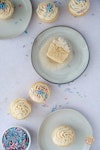
Why these vegan cupcakes shine
When I say these are the best vanilla cupcakes I've ever eaten (vegan or not), I don't say that lightly. I've tried many recipes from the internet and cookbooks, but none of them can compare to this one.
Before I was vegan, I had a cupcake business. And I based this vegan recipe on my top-secret, ultra-popular vanilla cupcake recipe.
This vegan cupcake recipe has a rich flavor because it uses vegan butter instead of coconut oil or canola oil. It also uses aquafaba as an egg replacer, which holds the cake together without weighing it down, resulting in a light and fluffy texture.
Although you can use all-purpose flour, using cake flour takes the softness to another level. I usually am not a big fan of vanilla, but I'm eating one of these cupcakes as I am writing this, and I can hardly believe how delicious it is.
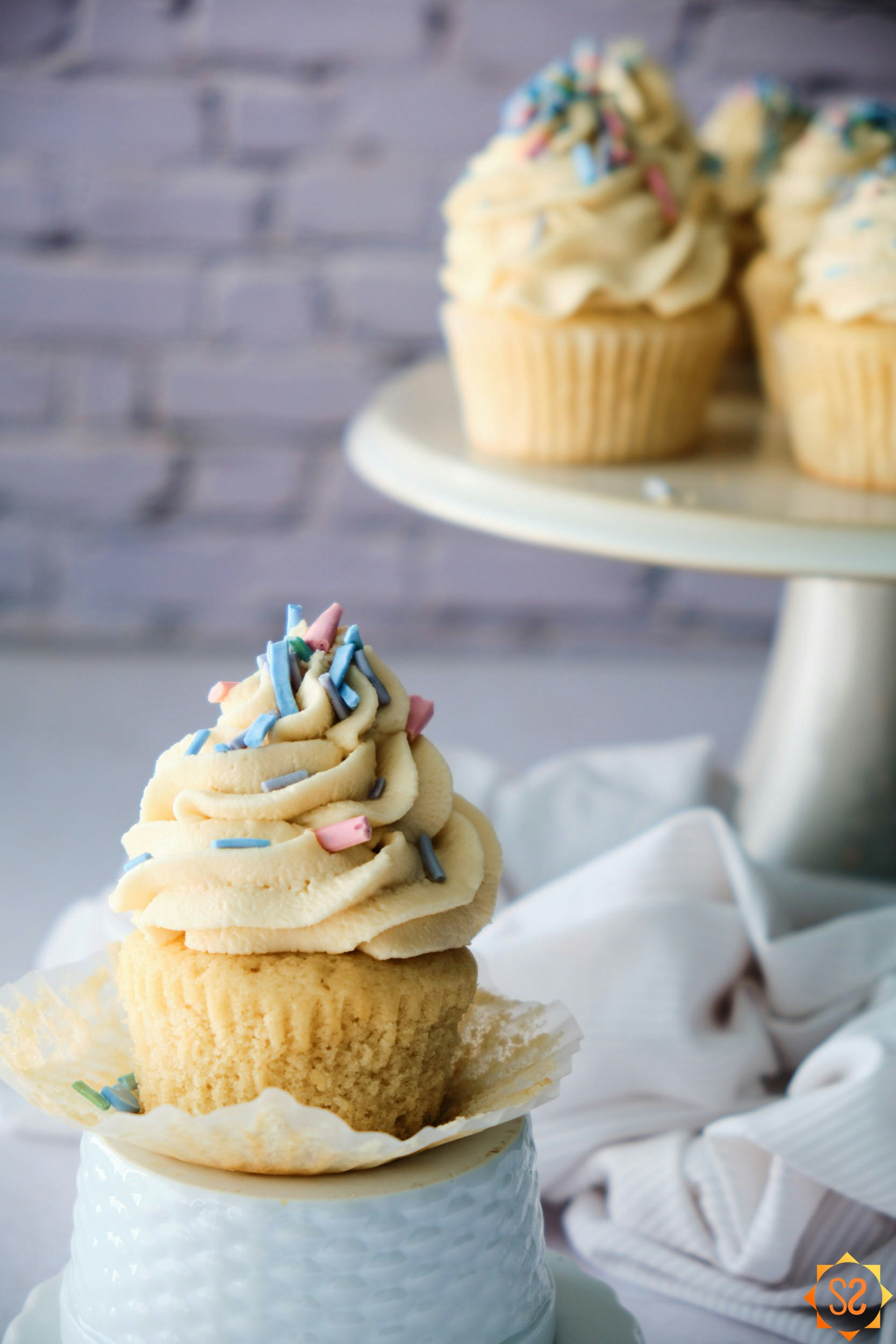
Ingredients and Substitutions
The ingredients for these vegan cupcakes are listed below, along with notes and substitution options:
Vegan butter sticks: For this recipe, choose a high-fat stick butter, not a spread. Earth Balance or Miyoko's work well, if you can get them. Make sure your butter is softened before you start, but keep an eye on it if your room is too warm (warmer than 74°F or 23°C) because most types of vegan butter will eventually melt at that temperature. If vegan butter is unavailable in your area, or unreasonably priced, try my homemade vegan butter recipe.
Granulated sugar: If you're in the US, make sure the sugar you're purchasing is vegan. Some sugar is whitened with animal bone char, making it not vegan. If you're not sure if your brand is vegan, buy organic; organic sugar can't be processed with bone char (in the US).
Aquafaba: This is the liquid from a can of chickpeas, and it acts as an egg replacer. I don't recommend using applesauce, flax eggs, or another egg replacer, as these are all heavier than aquafaba and will make the cupcakes too dense.
Vanilla extract: I recommend using real vanilla extract instead of artificial vanilla flavor. Artificial vanilla only contains one vanilla flavor: vanillin. But real vanilla contains hundreds of flavor notes.
White vinegar: This reacts with the baking powder to help the cupcakes rise. You can also use apple cider vinegar.
Cake flour: This is the best type of flour to use because it's finer and contains less gluten than all-purpose flour. However, I've made this recipe with all-purpose flour, too, and it's still delicious. Whatever type of flour you use, I recommend turning on metric measurements in the recipe and weighing it for best results.
Salt: Any type of fine-grain salt will work, including table salt, sea salt, or pink salt. Beginners to baking often wonder why sweet recipes contain salt; the answer is that a little bit of salt brings out the richness of all the flavors in the cake.
Baking powder: In combination with vinegar, causes the cakes to rise with a light, fluffy texture. If you don't have baking powder, you can also use 1 1/4 tsp. baking soda and 2 1/2 tsp. cream of tartar.
Plain, unsweetened almond milk: I always use almond milk in baking recipes because I get consistent results with it. I particularly like 365 almond milk (Whole Foods brand) or Blue Diamond Almond Breeze. You can also try other types of milk, but I find that some non-dairy milks (think oat milk, cashew milk) have different consistencies from one brand to another, resulting in different cupcake batter consistencies. If you do use a different type of non-dairy milk, choose one on the thinner side, and make sure it's plain and unsweetened.
Vegan buttercream frosting: For topping the cupcakes, you can click the link to find the recipe. Feel free to use your favorite store-bought vegan frosting, or another type of frosting, like my vegan cream cheese frosting.
Vegan sprinkles: Optional, but adds a splash of color and a bit of crunch. But be warned: most sprinkles aren't vegan, as they contain animal-derived colors (usually from insects). There are several brands of vegan sprinkles you can order online, and Whole Foods' 365 brand also has colorful vegan sprinkles.
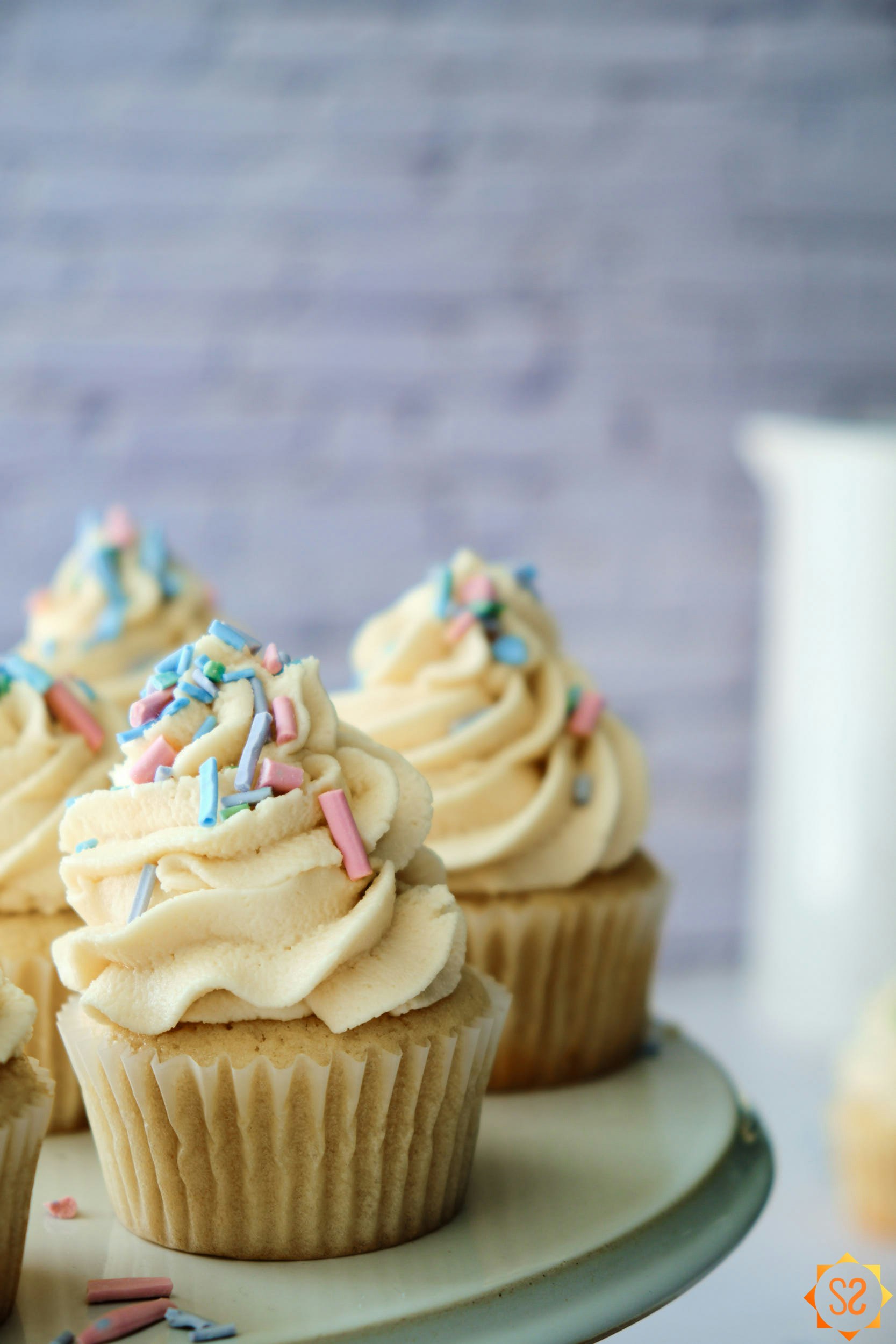
Tools you'll need (or want)
Stand mixer: This will make this recipe easier, but it's not required. You can also use an electric hand mixer or mix your batter by hand.
Cupcake pan and liners: This recipe is made for standard-sized cupcake trays and liners. If you use mini cupcake trays or jumbo cupcake pans, you will need to adjust your baking time (less time for smaller cupcakes and more time for larger cupcakes).
Pastry bag and large piping tip: If you'd like to pipe your frosting on top of your cupcakes, your best option is a pastry bag with a wide piping tip. You could also use a Ziploc freezer bag with a hole cut in the corner, or just use an icing spatula to spread the frosting on the cupcakes.
Kitchen scale: The best way to measure your flour is by weighing it. I recommend turning on metric measurements in the recipe card and using a kitchen scale for the flour. This is also useful when you're spooning the batter into the cupcake liners to make sure each cupcake is the same size. To do this, place your batter bowl on the scale (with the grams measurement on), and hit the "tare" button so the scale says 0 grams. Then remove batter and add it to a liner until the scale measures -55 grams. Then hit tare again and repeat with the next cupcake.
Frosting options and other toppings
These vegan cupcakes pair perfectly with my vegan buttercream frosting, which is an easy recipe made from vegan butter, powdered sugar, salt, and vanilla. You could also try them with my vegan cream cheese frosting recipe.
Top them off with vegan rainbow sprinkles, oreo pieces, vegan chocolate chips, coconut pieces, or even fresh fruit or berries.

How to pipe frosting onto cupcakes
To pipe frosting onto these vegan cupcakes, I recommend using a pastry bag with a large tip. You can use a round tip or a shaped tip (i.e. star-shaped), depending on how you want them to look. There are many different techniques you can use, but I find it's easiest to start at the edge of the cupcake, circle around and then spiral into the center. You could also hold the piping bag at the center of the cupcake and keep squeezing until the frosting spreads out to the edges.
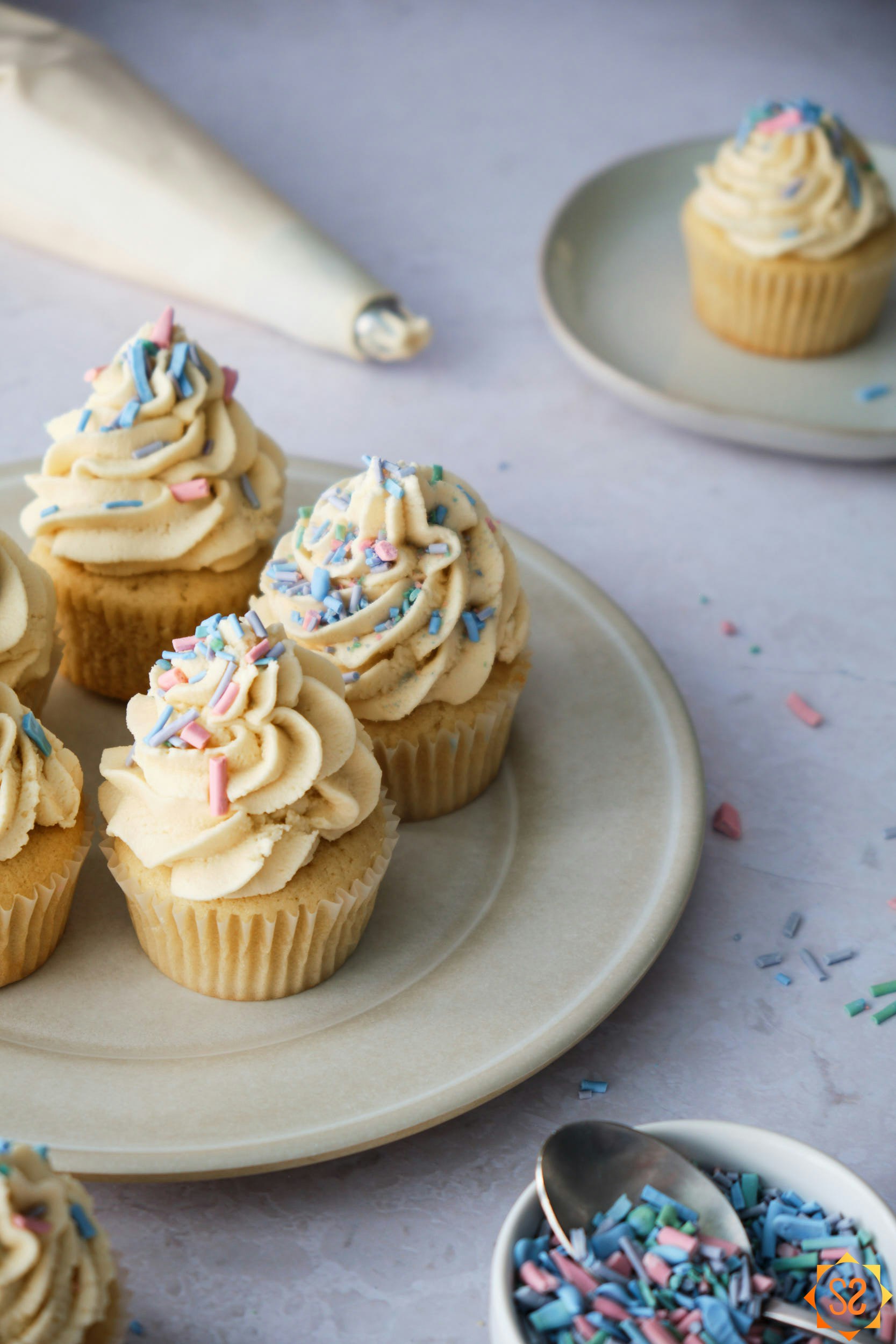
Steph's tips for perfect results
For best results, turn on the metric option at the top of the recipe below and weigh your ingredients. Flour in particular is difficult to measure with cups. The amount of flour in a cup can vary widely depending on how it's scooped.
Make sure your vegan butter is a high-fat stick butter, not a soft spread. Or use my homemade vegan butter recipe.
Before you start, allow your vegan butter to soften at room temperature, but don't let it get too warm. Don't try to microwave your vegan butter to speed up the softening process.
These cupcakes are soft and moist without any help. There's no need to add simple syrup for more moisture.
To make this recipe as a cake, use 2/3 of the amounts shown for a three-layer six-inch cake. Or, you can go directly to my vegan vanilla cake recipe.
Allow your cupcakes to cool completely before frosting, otherwise, your frosting may melt.
These cupcakes can be stored with frosting in an air-tight container at room temperature for 2-3 days, in the fridge for 5-6 days, or in the freezer for 3 months. If you haven't frosted the cupcakes yet, wrap them with plastic wrap so that moisture doesn't evaporate through the tops of the cupcakes.
More mouth-watering vegan cake and cupcake recipes
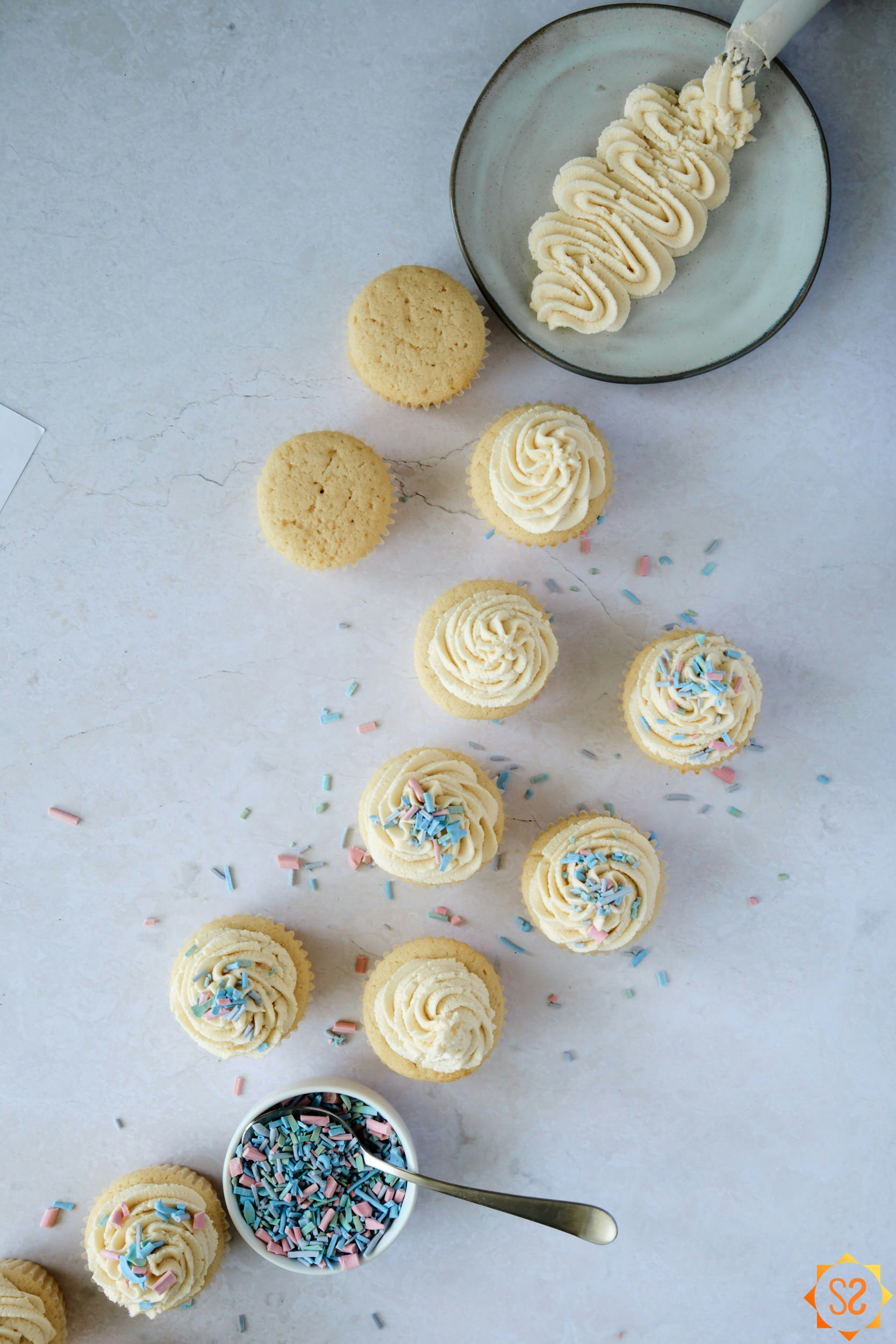
Vegan Vanilla Cupcakes
Yield24 cupcakes
Prep Time20 minutes
Cook Time22 minutes
Total Time42 minutes
Ingredients
- 2 cup vegan granulated sugar
- 3/8 cup aquafaba (liquid from a can of chickpeas)
- 1 tbsp. vanilla extract
- 1 tbsp. white vinegar (or apple cider vinegar)
- 3 3/8 cup cake flour*
- 1/2 tbsp. salt
- 1 1/2 tbsp. baking powder
- 1 cup plus 2 tbsp. plain, unsweetened almond milk (or other non-dairy milk)
- 1-2 batch vegan buttercream frosting
Instructions
Preheat your oven to 350°F (180°C). Then line two cupcake pans with 24 cupcake liners.
Add your vegan butter and sugar to the bowl of a stand mixer. Use the paddle attachment to cream the butter and sugar together at medium speed for 3-4 minutes, until well-combined and fluffy. A handheld electric mixer works, too. Alternately, you can do this by hand, but you will need to spend more time mixing the ingredients.
![Vegan butter and sugar creamed together in stand mixer bowl with paddle attachment on top.]()
Add aquafaba, vanilla, and vinegar to your butter mix, and cream again until well-combined.
In a separate large mixing bowl, sift together your flour, salt, and baking powder.
Add 1/3 of your dry ingredients to the stand mixer, then turn the mixer to medium-low until just combined. Then add 1/3 of your almond milk and mix again. If you need to, you can scrape down the sides of the bowl with a spatula. Repeat twice more until you’ve added all of your dry ingredients and almond milk. Be careful not to overmix the batter.
Use a pair of large spoons to scoop your batter into the liners. Fill each liner with 55 grams of batter (approximately 1 1/3 large spoonfuls).
Bake for 21-23 minutes, until a toothpick inserted into the center of a cupcake comes out clean, and the cupcake springs back when light pressure is applied.
Let your cupcakes cool in the pan until they’re cool enough to handle, then remove them from the pan and transfer them to a wire cooling rack to finish cooling.
After the cupcakes are completely cooled, frost them with vegan buttercream frosting. For a thin layer of frosting, use 1 batch, and spread the frosting on top of the cupcakes with an icing spatula. For a thicker, cupcake-shop-style layer of frosting, use a piping bag with a large tip to pipe 2 batches of frosting on top of the cupcakes.
(Optional) Add vegan sprinkles or other toppings to your frosting, and enjoy!
Notes & Hints
For more accurate measurements, I recommend weighing your flour on a kitchen scale instead of using a measuring cup. You can find the weight by turning the switch to "metric" at the top of the recipe card.
You can use all-purpose flour in this recipe, but the cupcakes won't be quite as soft.
More instructions for piping frosting onto the cupcakes are available in the blog post above.
These cupcakes can be stored with frosting in an air-tight container at room temperature for 2-3 days, in the fridge for 5-6 days, or in the freezer for 3 months.
Nutrition Data
Serving Size: 1/24 of recipe; Calories: 299; Fat: 12 g.; Saturated Fat: 6 g.; Cholesterol: 0 mg.; Sodium: 286 mg.; Carbohydrates: 47 g.; Fiber: 1 g.; Sugar: 31 g.; Protein: 3 g.; Vitamin A: 4 mcg. RAE; Vitamin B12: 0 mcg.; Vitamin C: 0 mg.; Vitamin D: 0 mcg.; Calcium: 54 mg.; Iron: 0 mg.; Potassium: 23 mg.; Zinc: 0 mg.Note: This data should be used only as an estimate. Please see the nutrition section of my terms and conditions for more information on how this data is calculated.
Vegan recipes in your inbox
Join the community and get my newest and best yummy vegan recipes sent right to your email!
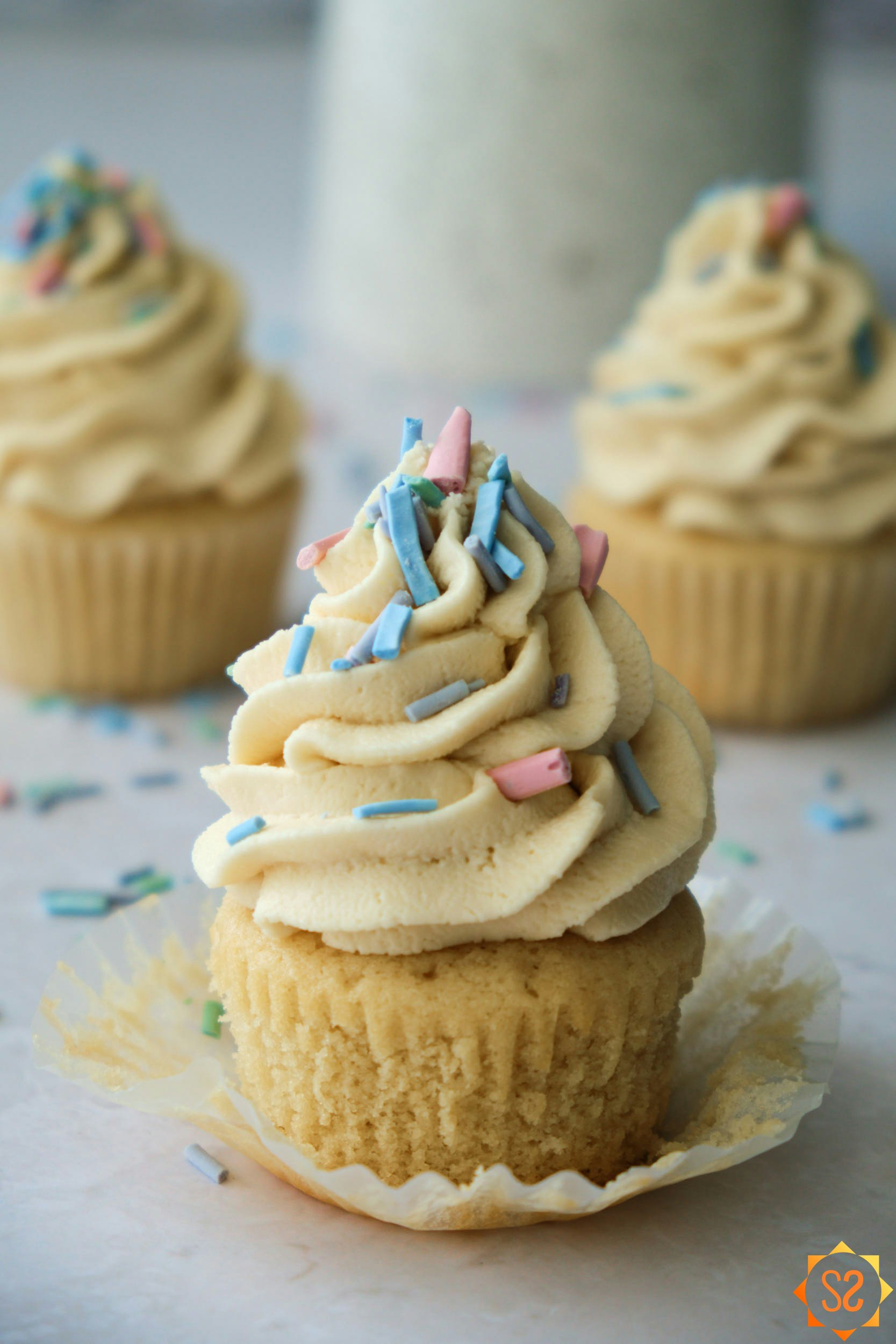
Share this:


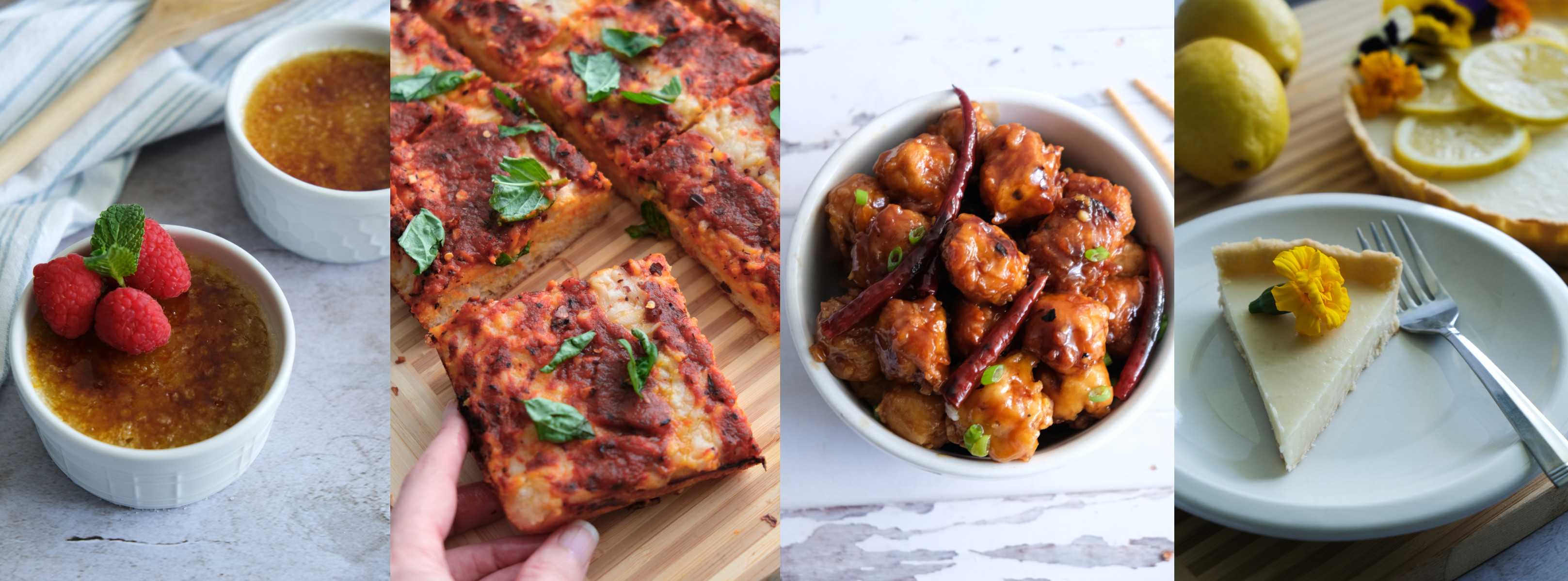
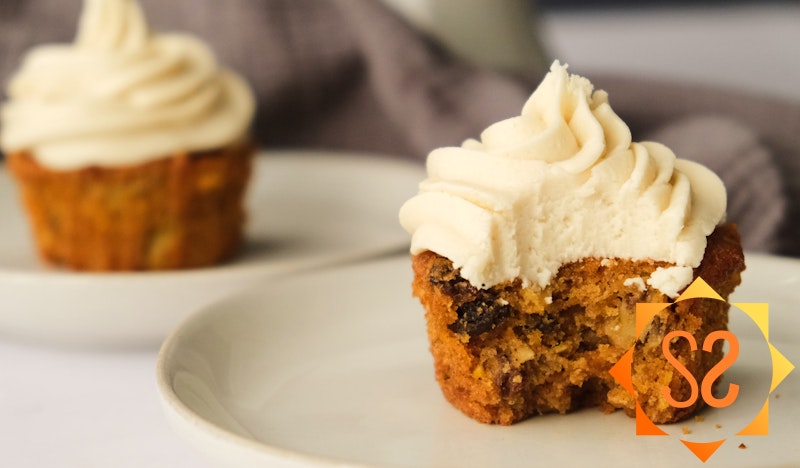
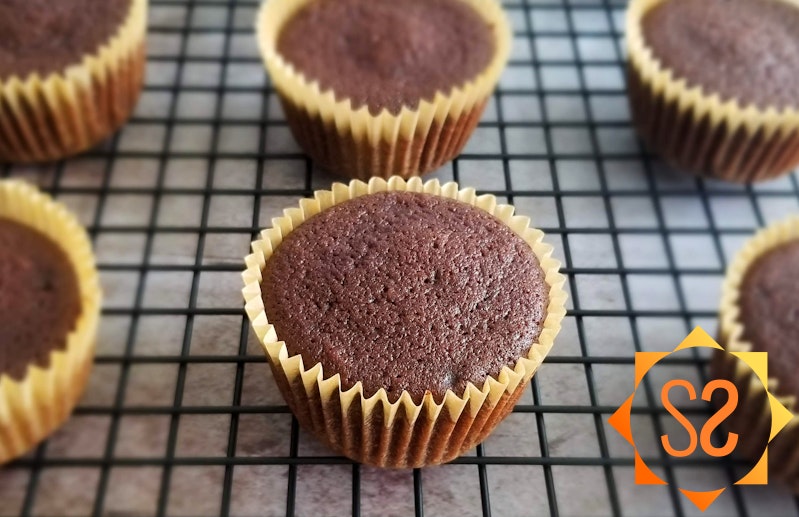
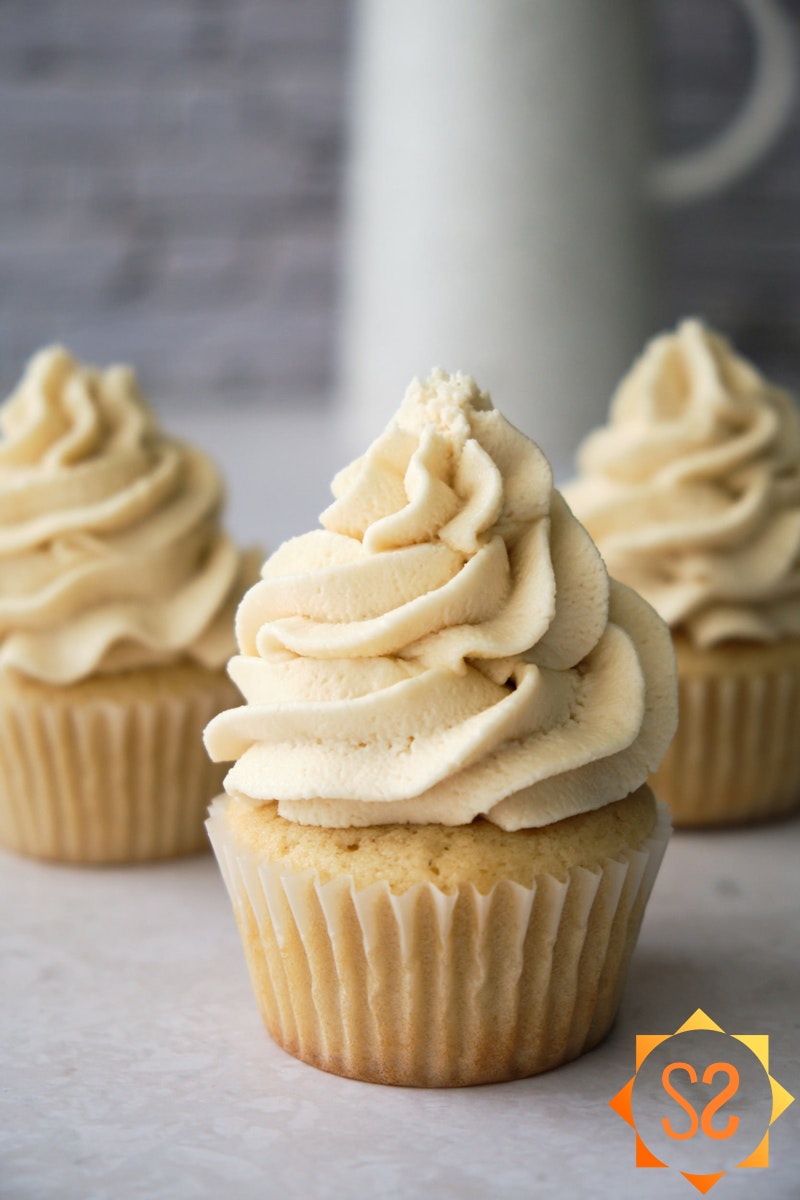
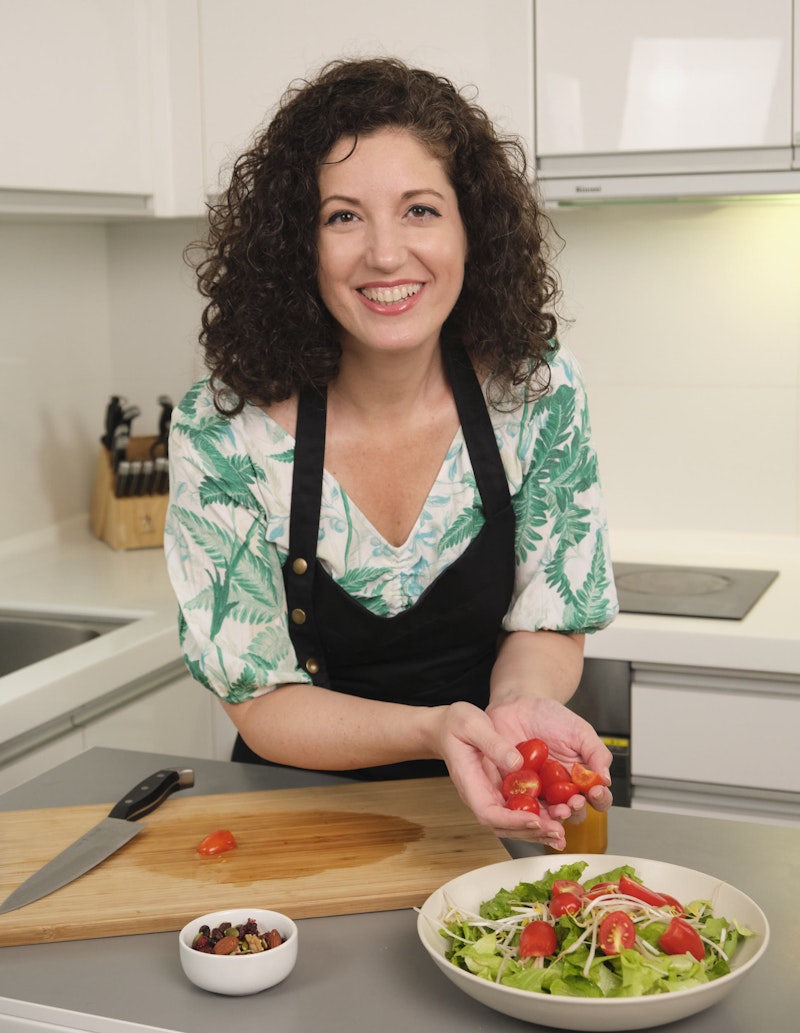


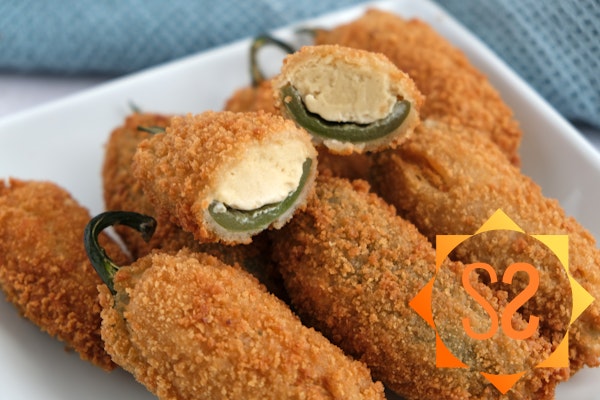


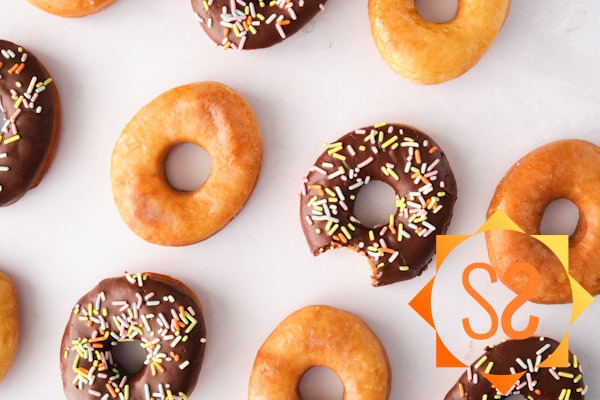
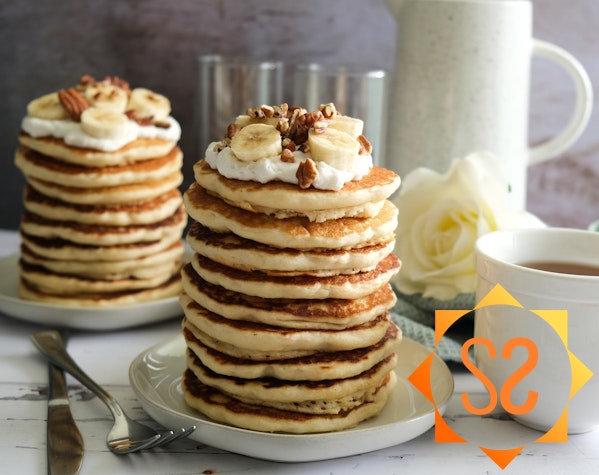
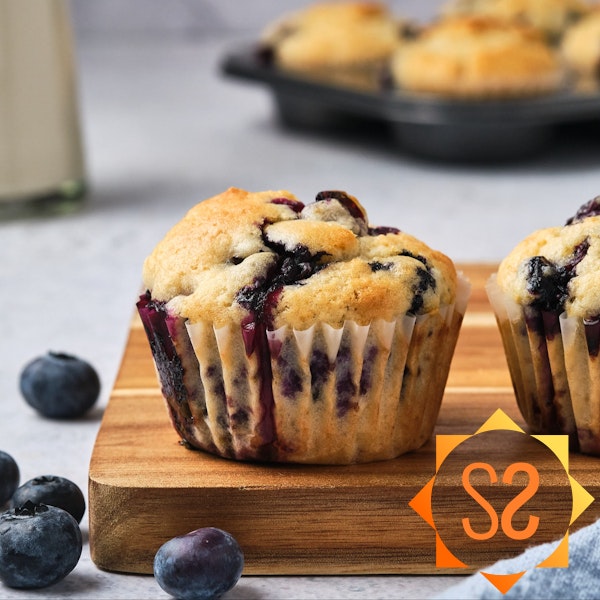
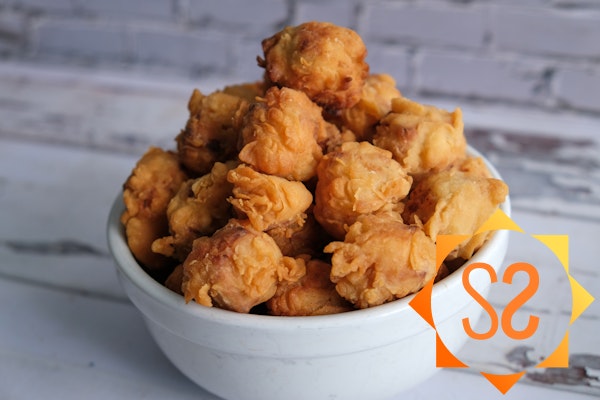

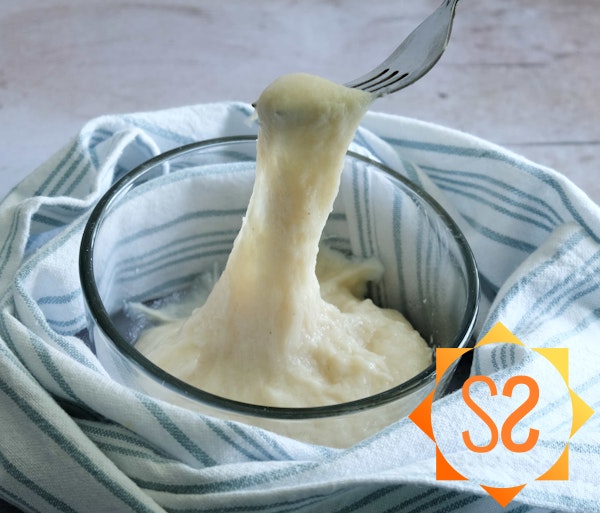

Leave a Comment
I love reading comments! I'll do my best to answer questions, too. If you made the recipe, please leave a star rating, it helps support the blog so I can make more recipes and articles. Thank you!
says